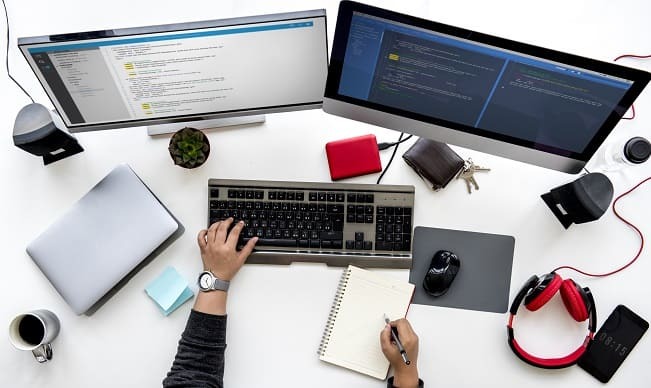
 Data Structure
Data Structure Networking
Networking RDBMS
RDBMS Operating System
Operating System Java
Java MS Excel
MS Excel iOS
iOS HTML
HTML CSS
CSS Android
Android Python
Python C Programming
C Programming C++
C++ C#
C# MongoDB
MongoDB MySQL
MySQL Javascript
Javascript PHP
PHPPhysics
Chemistry
Biology
Mathematics
English
Economics
Psychology
Social Studies
Fashion Studies
Legal Studies
- Selected Reading
- UPSC IAS Exams Notes
- Developer's Best Practices
- Questions and Answers
- Effective Resume Writing
- HR Interview Questions
- Computer Glossary
- Who is Who
What is the full form of COMPUTER?
Introduction
COMPUTER or Common Operating Machine Purposely Used for Technological and Educational Research is an electronic device that processes data and performs various operations according to instructions provided by a user or pre-programmed software.

Computers can perform a wide range of tasks, including data processing, calculations, communication, multimedia processing, gaming, and information retrieval.
History and Evolution of Computers
The history and evolution of computers span several decades and involve significant technological advancements.
Early Mechanical Calculators − In the 17th century, inventors like Blaise Pascal and Gottfried Wilhelm Leibniz developed mechanical calculators that could perform addition and subtraction.
Analytical Engine and Punch Cards − In the 19th century, Charles Babbage conceptualised the Analytical Engine, a mechanical general-purpose computer that used punch cards for input and output. Although it was never built, it laid the foundation for future computer designs.
Early Electronic Computers − The mid-20th century saw the development of the first electronic computers, such as the Colossus and ENIAC, which used vacuum tubes for electronic circuits.
Transistors and Integrated Circuits − In the late 1940s and early 1950s, transistors were invented, which led to the development of integrated circuits, which further miniaturised computers and paved the way for the modern era of computing.
Mainframes and Minicomputers − In the 1950s and 1960s, mainframe computers became popular in large organisations for data processing and business applications but were expensive. Minicomputers also emerged during this time, smaller in size and more affordable, catering to smaller organisations and research institutions.
Personal Computers − In the 1970s, the invention of microprocessors, such as the Intel 4004, led to the development of the first personal computers (PCs).
Microcomputers and the Internet Age: In the 1980s, microcomputers and home computers became popular, with brands like Commodore, Atari, and Amiga leading the market.
Mobile Computing and Cloud Computing − In the 2000s, mobile computing took off with the introduction of smartphones and tablets, providing portable computing power and access to the internet on the go. Cloud computing also emerged, allowing users to store and access data and applications remotely via the internet.
Modern Computing − Today, computing continues to evolve rapidly with advancements in areas such as artificial intelligence (AI), quantum computing, edge computing, and the Internet of Things (IoT), among others.
Components and Working of Computers
The main components of a computer are −
Central Processing Unit (CPU) − The CPU, often referred to as the "brain" of the computer, is responsible for executing instructions and performing calculations.
Memory − Memory, also known as RAM (Random Access Memory), is used to store data and instructions temporarily while the computer is in use.
Storage Devices − Storage devices, such as hard drives (HDDs) and solid-state drives (SSDs), are used for long-term storage of data and programs.
Input Devices − Input devices allow users to input data and commands into the computer. Common examples include keyboards, mice, touchscreens, scanners, and microphones.
Output Devices − Output devices display or produce the results of processed data. Examples include monitors, printers, speakers, and headphones.
Motherboard − The motherboard is the main circuit board that connects and allows communication between various hardware components of the computer, such as the CPU, memory, storage devices, and input/output devices.
Software − Software refers to the programs, instructions, and data that are stored on the computer and provide the instructions for the CPU to execute.
Application of Computers in different fields
Computers have revolutionised various fields and have become an integral part of modern society. Here are some examples of the applications of computers in different fields −
Business − Computers are extensively used in businesses for tasks such as accounting, inventory management, payroll processing, customer relationship management (CRM), and enterprise resource planning (ERP).
Education − Computers are used in educational institutions for instructional purposes, research, and administration. They provide access to online educational resources, enable online learning platforms, facilitate virtual classrooms, and support digital assessments.
Healthcare − Computers are used in healthcare for tasks such as patient record management, electronic health records (EHRs), medical billing, medical imaging and diagnostics, and drug discovery.

Science and Research − Computers play a crucial role in scientific research for data analysis, and scientific computing.
Communication and Networking − Computers are the backbone of modern communication and networking systems. They enable email communication, instant messaging, and video conferencing.
Entertainment − Computers are widely used in the entertainment industry for tasks such as video and audio editing, special effects, animation, game development, and virtual reality experiences.
Engineering and Design − Computers are extensively used in engineering and design fields for tasks such as computer-aided design (CAD), computer-aided engineering (CAE), simulation, and analysis.
Government and Public Services − Computers are used in government and public services for various tasks such as data management, citizen services, e- governance, digital record keeping, and public safety.
FAQs
What is a Computer?
Ans: A computer is a device that is capable of processing and storing digital information according to programmed instructions. It can perform a wide range of tasks, including data manipulation, calculation, communication, and multimedia processing.
What are the hardware components of a computer?
Ans: A computer system consists of several hardware components that work together to process and store digital information including the Central Processing Unit (CPU), Memory (RAM), Storage Devices, Input Devices, Output Devices, Motherboard, Power Supply and Cooling Devices.
How is data stored in a computer?
Ans: Data is stored in a computer using a binary system, which represents information using binary digits (0s and 1s). These binary digits, or bits, are used to represent the smallest unit of data in a computer.

